
Share on facebook Share on twitter Share on linkedin Table of Contents
- Motorcycle Accidents Statistics
- Motorcycle Death Statistics
- Causes of Motorcycle Accidents Statistics
- Motorcycle Accident Injury Statistics
- Factors That Have The Most Impact On Motorcycle Accidents
- Motorcycle Helmet Use Statistics
- 5 Tips for Motorcycle Safety
More than 8.6 registered motorcycles attest to their continued popularity as an economical mode of transportation. But, of course, any discussion about motorcycles eventually gets around to their lack of stability and ability to protect riders and passengers from serious injury in a crash.
The best way to better understand motorcycles and accidents that happen to people who ride them is by looking at motorcycle accident statistics. Accident statistics offer an insight into the common causes of accidents and things you can do, such as wearing a motorcycle helmet to reduce the risk of a crash and minimize the severity of the injuries in case of one.
If you ride a motorcycle, the data presented here will be of interest. As you read through this analysis of recent motorcycle accident statistics, you will find information to become a better and safer rider.
Motorcycle Accidents Statistics
As you can see from the accompanying chart from the National Safety Council, the number of registered motorcycles in the United States and the miles traveled remained relatively stable over the past nine years.
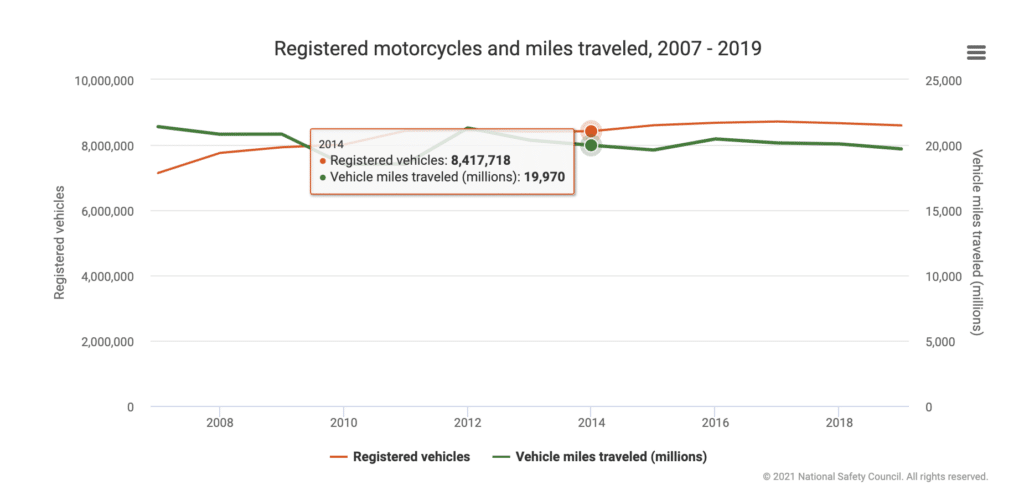
Source: National Safety Council
The stability of the two categories makes it somewhat easier to draw conclusions from an analysis of motorcycle accidents statistics without having to take into account dramatic fluctuations in the number of vehicles or the miles ridden.
Motorcycle Accidents Per Year
The challenge faced when researching motorcycle accidents is the absence of data available for the number of accidents occurring throughout the country over a year. The failure to report a motorcycle accident to the police or state motor vehicle departments may be the reason for the lack of data. There are, however, reliable statistics available to give insight into how motorcyclists compare with other motorists.
According to the most recently available data, 5,115 people died, and 79,000 were injured in motorcycle crashes in 2019. Motorcycles represent only 3% of all types of vehicles registered in the U.S. and account for only 0.6% of miles driven by all vehicles. Although the number of motorcycles, 8.6 million, registered in the U.S. pales compared to the 263.8 million other motor vehicles registered in this country, they account for 14% of all traffic fatalities, 17% of passenger fatalities or occupant deaths, and 3% of all injuries.
The chart displayed below shows how motorcycles stack up against cars and light trucks regarding the frequency of fatal accidents.

Source: Insurance Information Institute
What Are the Odds of Crashing a Motorcycle?
Riding on two wheels rather than four makes motorcycles less stable than other vehicles, which makes the rider’s skill level important in being able to maintain control. Whatever the reason for it, you have a greater chance of crashing a motorcycle than you do when driving in your car, truck, or SUV.
The chart below compares the rate of fatal collisions for different vehicles in 2010 and 2019, the most current year for which such data is available. As you can see from the chart, 25.98 fatal accidents involving a motorcycle occurred for each 100 million miles traveled in 2019 compared to only 1.42 collisions for passenger cars using the same number of miles.
The comparison of motorcycles to cars becomes even more striking when looking at the rate of fatal crashes per 100,000 registered vehicles. Motorcycles had a fatal crash rate of 59.49, while the rate for cars was 15.06.
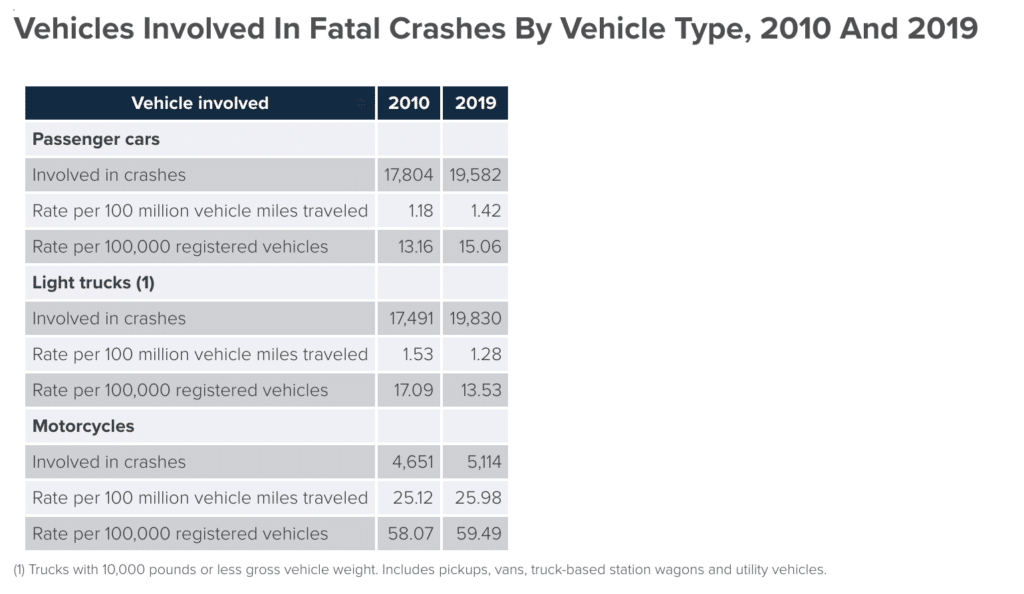
Source: Insurance Information Institute
What Type of Motorcycle Has the Most Accidents?
Design, engine size, and equipment vary from one type of motorcycle to another, as does the rate of accidents. Some of the most popular types of motorcycles include:
- Cruisers:
- Standards:
- Sportbikes:
- Super sports:
Of all types of motorcycles registered in the U.S., one study found the fatal crash rate for super sports to be four times greater than any of the other types.
What State Has the Most Motorcycle Accidents?
California and Florida rank as the top two states in terms of registered motorcycles, but the deadliest state is Louisiana, with a rate of fatal accidents of 21.1 per 10,000 registered motorcycles. South Carolina had a fatality rate of 13.1, and Mississippi ranked third at 12.7.
Motorcycle Death Statistics
The opportunity to cruise along scenic highways without a steel cage obstructing your ability to see, hear and experience your surroundings is one of the attractions of riding a motorcycle. It also represents why motorcycle riders are 29 times more likely to die in a crash, based on a comparison of vehicle miles driven, than drivers and passengers of other types of vehicles.
Analysis of available data about fatal motorcycle accidents provides a better understanding of their causes and factors contributing to the death of a rider instead of a survivable injury. This, in turn, can help save lives by developing new safety features and the increased use of currently available equipment, such as anti-lock brakes and helmets, that offer riders better control over their vehicles or provide increased protection when they crash.
What Percentage of Motorcycle Accidents Result in Death?
They may be fun and economical to ride, but the odds of surviving a motorcycle accident are against you. As previously cited, the NHTSA reports that you are 29 times more likely to be killed in a collision than occupants of other types of motor vehicles, and 5,014 riders died in crashes in 2019.
What Type of Motorcycle Accident Causes the Most Deaths per Year?
The accompanying chart shows that single-vehicle crashes, such as a motorcyclist losing control of the vehicle on a wet or snow-covered road account for 39.87% of fatal accidents. The majority of fatal crashes, 52.61%, involved a motorcycle and one other vehicle. The remaining fatal crashes involved three or more vehicles.
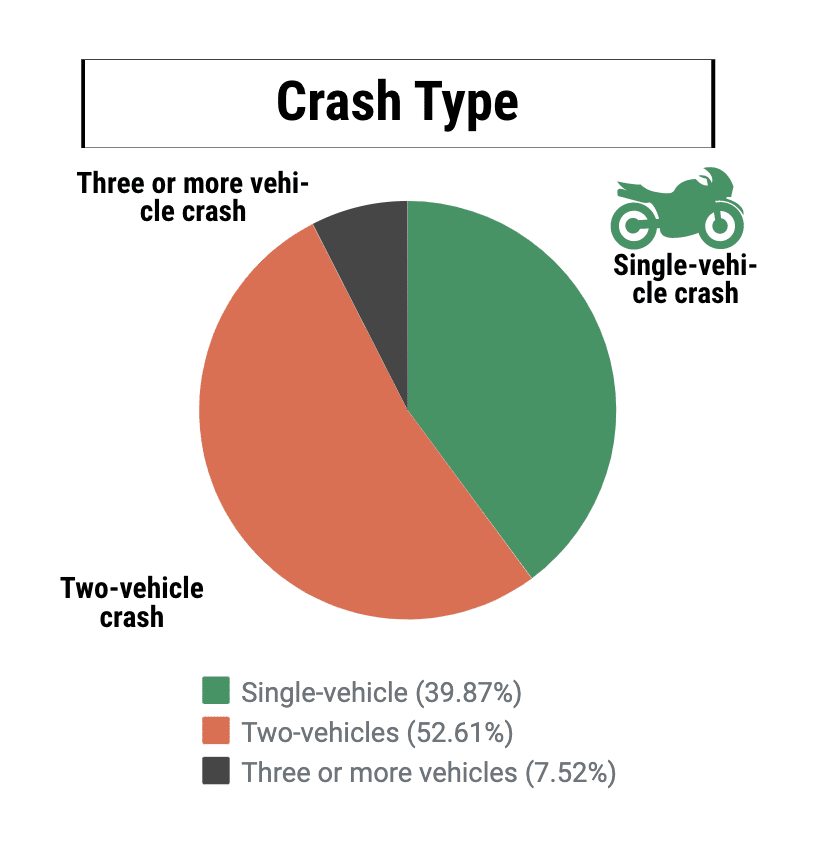
Source: National Safety Council
What State Has the Most Motorcycle Accident Deaths per Year?
Using crash data for 2019, the National Safety Council reports the following states as having the highest number of fatal motorcycle accidents:
- Florida (591)
- California (474)
- Texas (416)
- North Carolina (208)
- Pennsylvania (176)
Weather that allows for year-round use of motorcycles may be a reason for the high fatality rate in Florida and the fact that cold-weather states, such as Alaska with six fatalities, do not have as many deaths due to motorcycle crashes.
Causes of Motorcycle Accidents Statistics
According to the NHTSA, in 2019, motorcycle accidents in the U.S. claimed the lives of 5,014 riders and injured another 84,000. Not only were motorcyclists 29 times more likely to die in a crash than drivers and passengers of other types of vehicles, but they were four times more likely to be injured.
The smaller size relative to other vehicles makes it easier for a motorcycle not to be seen by other drivers. The lack of a protective cage and safety features, such as seat belts and airbags, that other vehicles have as standard equipment increase the likelihood that an accident will result in a motorcyclist being taken to a hospital.
The Most Common Causes of Motorcycle Accidents
The behavior of drivers and motorcyclists appears as the underlying cause of accidents, including:
- Alcohol and drug impairment.
- Distracted driving.
- Reckless driving.
- Speeding.
- Road rage.
- Poor or impaired visibility.
- Drowsy or sleepy.
- Improper lane use, including lane splitting.
The NHTSA reports that 42% of motorcyclists killed in single-vehicle crashes were impaired by alcohol, and 30% of riders did not have a valid license to operate a motorcycle.
Motorcycle vs. Car Accidents
The fact that car accidents occur more frequently than motorcycle accidents should not be a surprise considering that cars far outnumber motorcycles. However, when broken down by the rate of fatal crashes per 100,000 registered vehicles, it shows that 58% of motorcycles versus 9.4% of cars were involved in fatal collisions.
Motorcycle vs. Truck Accidents
The chart below shows how motorcycles compare to trucks and cars regarding the rate of involvement in fatal crashes. Less than 1% of trucks were involved in fatal crashes compared with 25% of motorcycles based on the rate per mile traveled. Trucks also did better based on the rate per 100,000 registered vehicles at 6.8% versus 58% motorcycles.

Source: Insurance Information Institute
Motorcycle Accident Injury Statistics
The statistics presented so far highlight the dangers and risks confronting motorcyclists, particularly about fatalities. Whether taken from the perspective of vehicle miles traveled or the relative number of registered vehicles, motorcyclists have a much lower survival rate than occupants of other types of vehicles.
Motorcyclists do not fare much better when you look at the data for injury rates. The likelihood of a rider suffering an injury in a crash is four times greater than a driver or passenger riding in a car or truck.
Motorcyclist Injuries and Injury Rates by Year
The table presented shows injuries and injury rates for motorcyclists over the nine years from 2010 through 2019. It is the most currently available data derived from the NHTSA.
The 84,000 motorcyclists injured in crashes in 2019 increased 2% from the previous year when there were 2,000 fewer injured riders. This is notable because the number of registered motorcycles in the U.S. declined by 63,427, but the injury rate per 100,000 registered motorcycles increased slightly more than 3% over 2018.
Motorcycle Injuries by Type
An extensive study of accidents and injuries caused to riders found that some of the common injuries suffered by motorcyclists and the frequency of occurrence to be the following:
- Lower extremity injuries occurred in 47% of collisions.
- Upper extremity injuries occurred in 40% of collisions.
- Head injuries occurred in 35% of collisions.
- Chest injuries occurred in 31% of collisions.
- Spine injuries occurred in 20% of collisions.
- Abdomen injuries occurred in 15% of collisions.
- Face injuries occurred in 10% of collisions.
A person on a motorcycle that crashes into another vehicle or stationary roadside object at highway speeds will most likely suffer severe and extensive injuries over several parts of the body.
Factors That Have The Most Impact On Motorcycle Accidents
Data collected about motorcycle crashes point toward the four factors, geographic, time of day, weather, and intoxicated driving, displayed in the accompanying charts as impacting motorcycle accidents.
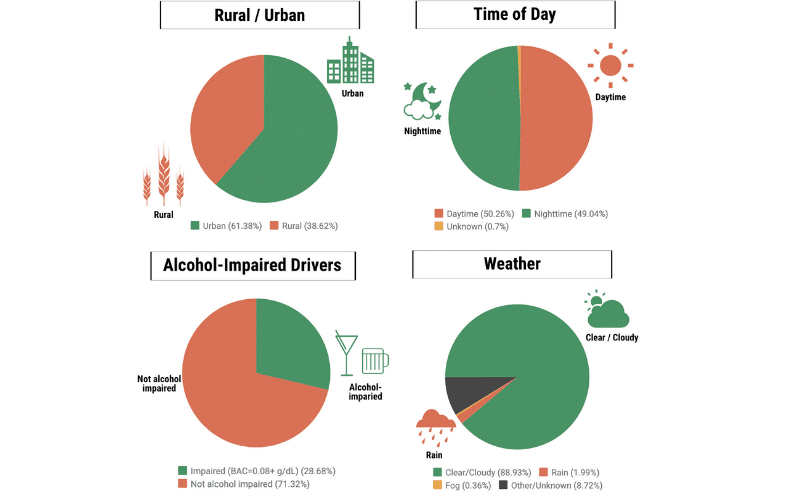
Source: National Safety Council
Geographic
If you live in a city or other urban area, you have a greater risk of being involved in an accident than you would if living in a rural area. For example, 61% of fatal motorcycle crashes occurred in urban settings and slightly under 39% in rural areas.
Time of day
Most fatal accidents occur between noon and 9 p.m. during the week. However, the most dangerous weekend hours for motorcycle riders are between noon and midnight. The rate at which they occur seems to be split almost equally between daytime and nighttime hours.
Weather
If you were asked to guess the type of weather conditions that prove most dangerous for motorcycle riders and guessed rain or snow, you are wrong. Just about 89% of fatal motorcycle accidents occur when the skies are clear or cloudy. Only about 2% of accidents can be attributed to roads or visibility affected by rain. Fog, which you might have imagined obscuring visibility and increasing the risk of crashing, was a factor in less than 1% of fatal accidents.
Intoxicated Driving
Of the fatal motorcycle accidents occurring in 2019, the NHTSA found that 29% of the motorcycle operators were intoxicated. It also found that 40% of the riders between 40 and 44 years of age who died in crashes in 2019 were drunk.
Motorcycle Helmet Use Statistics
Motorcycle helmets save lives and reduce the severity of injuries to riders and their passengers. Estimates show helmets to be 37% effective in preventing rider fatalities and 41% effective in preventing passenger deaths.
Motorcycle Helmet Use by Year
This chart from the NHTSA shows the percentage of motorcyclists using a DOT-approved helmet. It covers the years from 2011 through 2020.

Source: National Highway Traffic Safety Commision
Lives Saved From Motorcycle Helmet Use
Government estimates show that more than 25,000 lives have been saved since 2002 through helmets by motorcyclists. This chart from the National Safety Council shows you the percentage of riders wearing helmets and the lives saved in any year from 2002 through 2019.
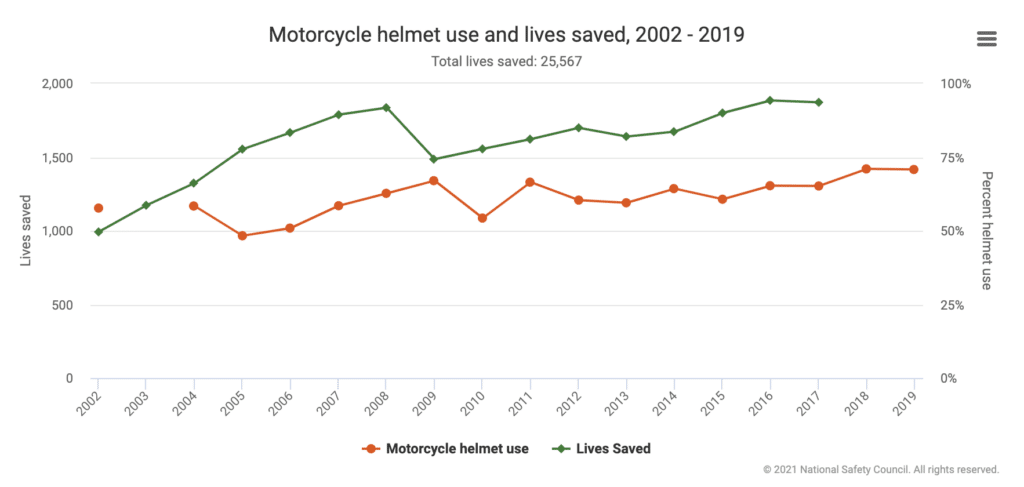
Image courtesy of the National Safety Commision
Motorcycle Helmet Use by State Law and Helmet Type
Currently, 19 states and the District of Columbia have universal helmet laws requiring their use by all motorcyclists. Three states have no laws on helmet use, and the remaining states have laws requiring helmets, requiring them only for some riders, such as those under 21 years of age. The chart from the NHTSA compares helmet usage by type of helmet and the percentage of riders wearing them in states with and without universal helmet laws.

Source: National Highway Traffic Safety Commission
5 Tips for Motorcycle Safety
Now that you have all of the statistics about the dangers of riding a motorcycle, here are five tips that may help ensure that you arrive at your destination safe and unharmed:
- Awareness always: Some people may prefer to call it defensive riding. Still, you need to be alert to situations that may endanger your safety. Leaving sufficient space between your motorcycle and the vehicle ahead of you and staying out of other blind spots are only a few examples of always being aware and alert.
- Make yourself visible: Wear bright clothing during the day and clothing made with reflective material at night to make you more visible to other motorists. Reflective tape applied to your helmet increases visibility. Being visible includes staying out of blind spots.
- Wear appropriate safety gear: Regardless of the laws in your state, wear a DOT-approved motorcycle helmet that fits you properly and have it securely fastened at all times. Safety glasses or a face shield attached to your helmet protect your eyes. Long sleeves and pants along with gloves protect you from injury should you be knocked off your bike.
- Ride a motorcycle that suits you: A too big, too heavy, or overpowered motorcycle is difficult to control and increases the risk of an accident. Buy a motorcycle that you can control, particularly when you need to maneuver out of a dangerous situation.
- Anticipate conditions: It may be a clear, sunny day when you start your ride, but weather conditions can quickly change and result in you riding in rain or snow. After checking the weather forecast before heading out, make sure you also look at the route you plan to take and the address of your destination.
Keep in mind that most of the common causes of motorcycle accidents were related to the behavior of the motorist and motorcycle rider. Therefore, making yourself a better rider will make you a safer one as well.


